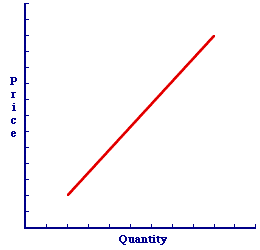
|
|
DISEQUILIBRIUM, AGGREGATE MARKET: The state of the aggregate market in which real aggregate expenditures are NOT equal to real production, which result in imbalances that induce changes in the price level, aggregate expenditures, and/or real production. In other words, the opposing forces of aggregate demand (the buyers) and aggregate supply (the sellers) are out of balance. Either the four macroeconomic sector (households, business, government, and foreign) buyers are unable to purchase all of the real production that they seek at the existing price level or business-sector producers are unable to sell all of the real production that they have available at the existing price level.
Visit the GLOSS*arama
|
|


|

|
                           OTHER PRICES, SUPPLY DETERMINANT: The prices of other goods that influence the decision to sell a particular good, which are assumed constant when a supply curve is constructed. Other prices can be for goods that are either substitutes-in-production or complements-in-production. This is one of five supply determinants that shift the supply curve when they change. The other four are resource prices, production technology, sellers' expectations, and number of sellers. The supply for one good is based on the prices of other goods that use the same resources for production. A change in the price of a substitute good (or substitute-in-production) induces sellers to alter the mix of goods produced, that is, to produce more of one good and less of another. An increase in the price of a substitute motivates sellers to sell less of this good as more of the substitute good is produced. A change in the price of a complement good (or complement-in-production) induces sellers to supply more or less of both goods, jointly. An increase in the price of a complement motivates sellers to sell more of this good as they sell more of the complement good, too.Substitute and ComplementWhen it comes to the other prices supply determinant, goods fall into one of two types--substitute and complement.- Substitute-in-Production: A substitute-in-production is one of two (or more) goods that is produced using the same resources in an either/or fashion. Supplies produce one good or the other, but not both. Devoting resources to the production of one good means they cannot be used to produce the other. An example is using farmland and other resources to produce one of two crops, either corn or soybeans.
- Complement-in-Production: A complement-in-production is one of two (or more) goods that is produced jointly with a given resource. One good is often produced as a bi-product of another. Producing one good does not prevent production of the other, but actually enables production of the other. Examples include beef and leather, both produced from the same cow.
Shifting the Supply Curve| Other Prices |  |
Changes in the prices of other goods cause the supply curve to shift. This can be illustrated using the positively-sloped supply curve for Wacky Willy Stuffed Amigos presented in this exhibit. This supply curve captures the specific one-to-one, law of supply relation between supply price and quantity supplied. Other prices are assumed to remain constant with the construction of this supply curve.Now, consider how changes in other prices shift the supply curve. The supply curve is affected in a different way for a change in the price of a substitute good than for a complement good. - Substitute-in-Production: An increase in the price of a substitute good causes a decrease in supply and a leftward shift of the supply curve. With the higher price, sellers sell more of the substitute good and less of this good. Click the [Other Price Up] button under the Substitute-in-Production heading to demonstrate.
A decrease in the price of a substitute good causes an increase in supply and a rightward shift of the supply curve. With the lower price, sellers sell less of the substitute good and more of this good. Click the [Other Price Down] button under the Substitute-in-Production heading to demonstrate.
- Complement-in-Production: An increase in the price of a complement good causes an increase in supply and a rightward shift of the supply curve. With the higher price, sellers sell more of the complement good and thus more of this good, too. Click the [Other Price Up] button under the Complement-in-Production heading to demonstrate.
A decrease in the price of a complement good causes a decrease in supply and a leftward shift of the supply curve. With the lower price, sellers sell less of the complement good and thus less of this good, too. Click the [Other Price Down] button under the Complement-in-Production heading to demonstrate.

Recommended Citation:OTHER PRICES, SUPPLY DETERMINANT, AmosWEB Encyclonomic WEB*pedia, http://www.AmosWEB.com, AmosWEB LLC, 2000-2025. [Accessed: July 9, 2025].
Check Out These Related Terms... | | | | | | | | | |
Or For A Little Background... | | | | | | | | | |
And For Further Study... | | | | | | | | | | | |
Search Again?
Back to the WEB*pedia
|



|

|
|
In the Middle Ages, pepper was used for bartering, and it was often more valuable and stable in value than gold.
|

|
|
"All labor that uplifts humanity has dignity and importance and should be undertaken with painstaking excellence. " -- Martin Luther King Jr., civil rights leader
|

|
M&O
Management and Organization
|

|
|
Tell us what you think about AmosWEB. Like what you see? Have suggestions for improvements? Let us know. Click the User Feedback link.
User Feedback
|


|


